Adored by critics and film-goers alike, the Best Picture Oscar-winning film The Artist is worthy of the many accolades it has received. After we parsed the tuxedos worn during the 2012 Oscars ceremony, we’d like to share some of the charming elements of the winning film with you today – most especially the men’s clothes!
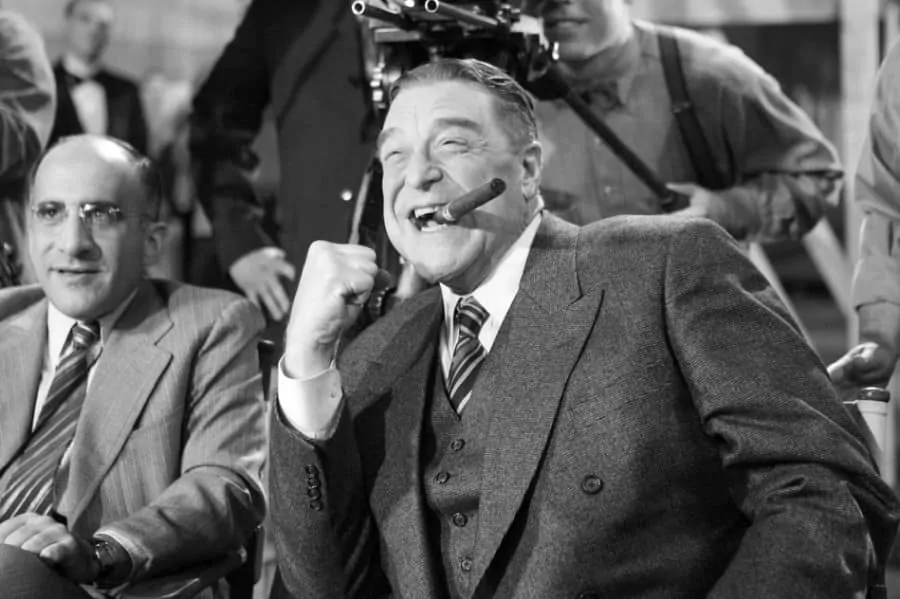
Set in the late 1920’s and early 1930’s, for our purposes, The Artist occurs during the golden era of classic men’s style in the US. At the time, talkie films were emerging, and actors like Fred Astaire were beginning their ascent into stardom. The picture is beautifully shot in black and white film, and like the main character George Valentin, the film is mostly silent. The occasional sound effect and appropriately tinny, vaudevillian music are the only accompaniments. For the viewer, it takes a little while to adjust to such a drastically different viewing experience – the sound is noticeably quieter, the vivid colors and textures of HD film are gone, and the shooting style is restricted to era-specific camera methods, most often from stiff floor-mounted cameras. Clearly, the director went to great lengths to mimic the original features of a silent production. The plot relies heavily on facial expressions, context, and body language to convey the development of the plot. At the very least, The Artist is the most interesting and unique film composition of the awards season.
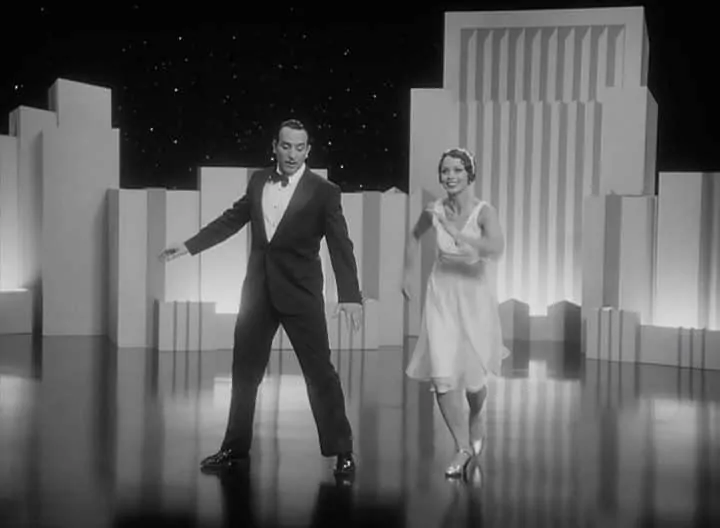
The Plot
For those of you who have not seen the film, and would prefer to not have the plot revealed, please continue down to the section entitled “The Clothes.”
In 1927, George Valentin (a likely reference to Rudolph Valentino, the famed early silent film star) is the immensely popular silent film star under contract with Kinograph Studios. His dog Uggie is his film sidekick by day and his loyal companion by night. At the opening night of Valentin’s most recent film, he bumps into a female fan, Peppy Miller, who is there to get his autograph. A photo of the moment is featured in the paper the next day, and when Peppy turns up as an extra on his next film, the studio manager Al Zimmer (played by John Goodman) tries to throw her out. Valentin steps in, and insists that she participates. Valentin is clearly taken with her, and with a little guidance from her famous associate, the film turns out to be the start of Peppy’s successful film career.
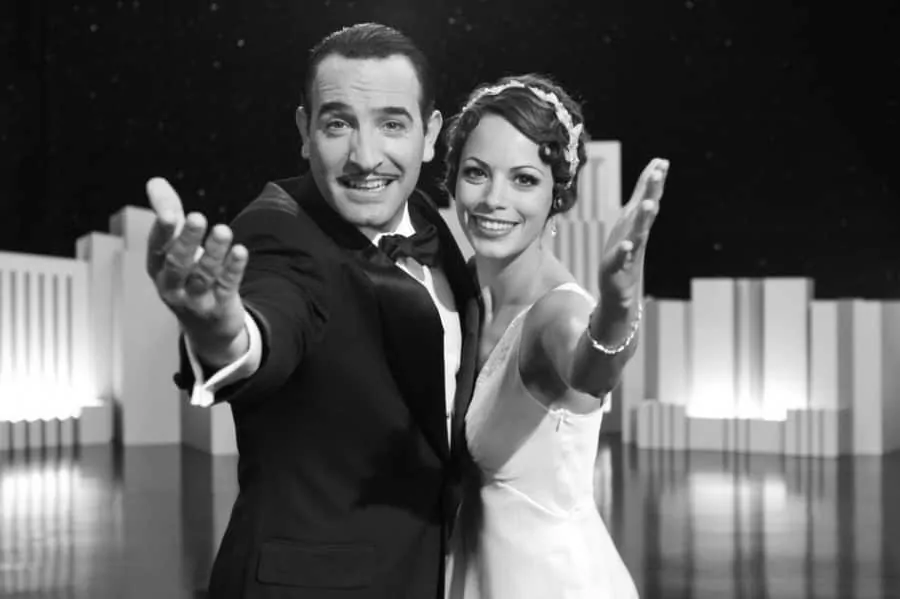
In 1929, the stock market crash is looming and Kinograph decides to discontinue silent films in favor of talkies, citing Peppy as one of the new faces of Hollywood. Disbelieving, George finances and produces his own silent film. Sadly, it is a pitted directly against Peppy’s new film and is a total failure. Valentin’s wife leaves him, and he is destroyed financially and professionally. We reconnect with George as he is living in a dingy tow room apartment, having sold all of his valuable possessions. Clearly haunted by the loss of his livelihood, Valentin sets his private film collection on fire. His dog brings help, and George is hospitalized for injuries sustained in the fire. Peppy visits him in the hospital, and learns that he was found protecting one film, which she discovers was the film George insisted she join. George awakens at Peppy’s house, and while wandering he discovers a room entirely filled with his auctioned property – all purchased by Peppy. Distraught, he contemplates suicide, but Peppy finds him in time. They reconcile, and recalling George’s talent for dancing, Peppy makes a musical with him. In the last scene, we see a restored Valentin happily dancing with Peppy, amid fully articulated sound. When asked to do the scene again, George responds “with pleasure” in heavily accented French, revealing his hesitancy to join the talkies.
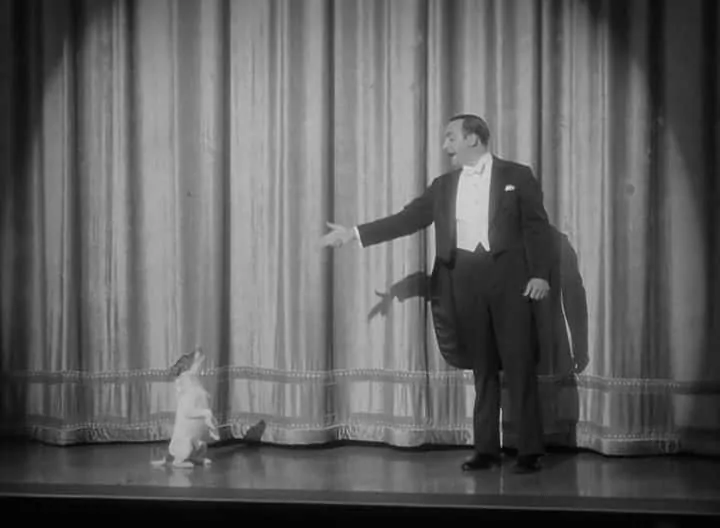
The Clothes
Considering the director’s concern for technical detail, I had high hopes for the film wardrobe – especially for the male characters. Other than main actor George Valentin, not many men have a chance to display their clothes for more than a few seconds. The one exception is Al Zimmer, but even he is rarely onscreen for long.
Other than a few tweed suits and sportscoats, we mostly see evening wear: tailcoats and tuxedos. Throughout the film, Valentin wears the same tailcoat and vest, switching only between white and black bow ties. In fact, black bow ties were never worn with a tailcoat, unless you were the server at a restaurant or if you were attending a funeral. Even then, most men would have worn a black waistcoat and not a white one.
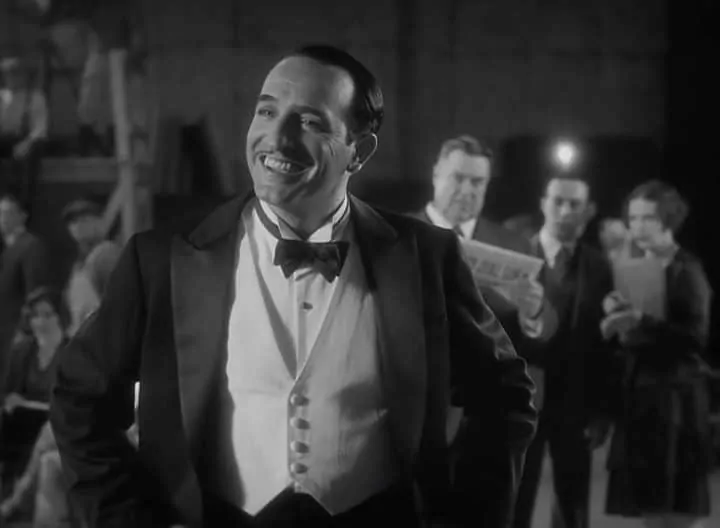
Tailcoats & Tuxedos
Valentin’s waistcoat is made of white piqué cotton fabric and has cloth-covered buttons, but it is soft and it has the cut of a day waistcoat, not an evening waistcoat. This means the V is rather high, whereas traditional evening vests would have had a deep U or V cut to display one’s shirt front and studs properly. Also, evening waistcoats would have been starched – not soft. On top of that, the vest is a little to short at the bottom, leaving the main actor’s waistband exposed many times and revealing the shirt underneath.
The evening shirts in the 20’s and 30’s had stiff detachable collars, but in the movie, you only see modern day evening shirts with attached, unstarched collars. At least they tried to use single cuffs for tailcoats and double cuffs for tuxedos!
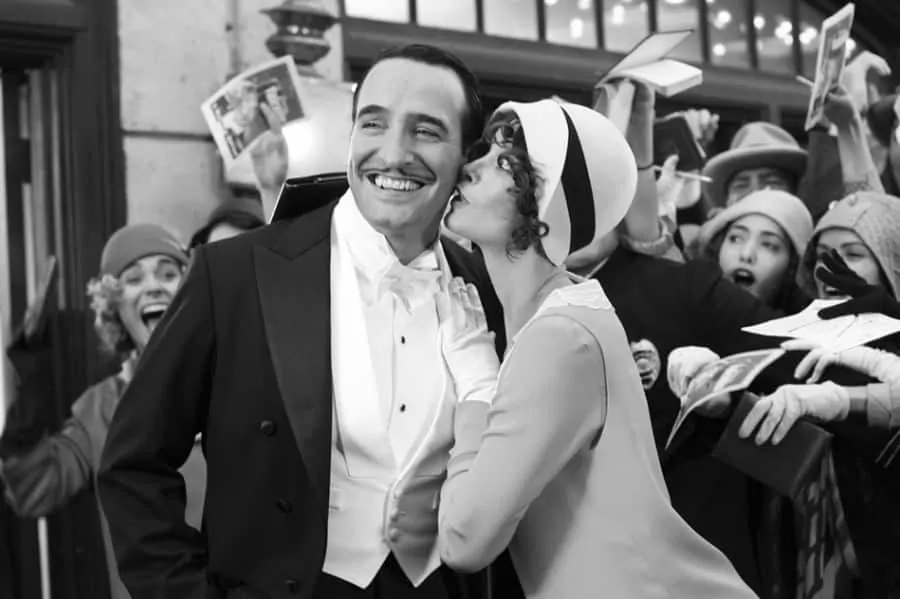
The tailcoat trousers lack a double galon stripe, even though this remains the absolute standard for men’s evening wear to the modern day.
His shoes are only clearly visible in one scene, and it seems like he wore black patent leather oxfords without a captoe, which was absolutely correct back then.
However, it is doubtful that a man of his resources would have worn an adjustable bow tie – it’s a faux pas for formal occasions as it is! He much rather would have donned a sized one that fit his neck.
The tailcoat itself has lapels that remind me a little bit of the late 1920’s, although the trousers are full cut and more 1930’s style. Most people assume that clothes during that period were all the same, but that couldn’t be further from the truth. In the 1920’s suits were cut more closely to the body, and trousers were much narrower. In the 1930’s the drape cut created more room over the chest, lapels got wider, and the shoulder and pants became fuller. In The Artist, the blending of the genres deprives the leading man of authenticity in his dress. What a shame!
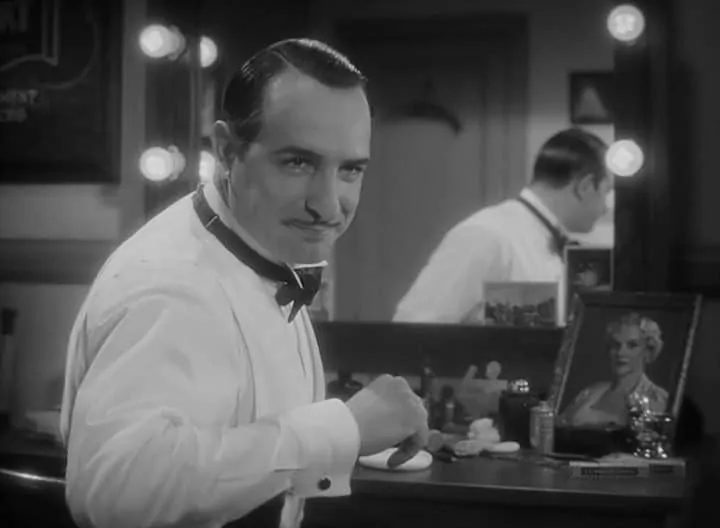
At the very end of the movie, we can see the two main characters dancing like Fred Astaire and Ginger Rogers. In the close up, you can see that Dujardin wears a tuxedo with flaps on the pockets – again, a highly informal detail that no elegant man would have worn back then.
On the other hand, I must say his mustache looks always superb! Also, the ties and suspenders he wears look very 30’s. His casual suits and jackets are neither 1920s nor 1930s, but something in between. With regards to the fabric, it seems like they tried to find something more authentic but the cut of the waistcoat – with the bottom button fastened – is not the way most elegant men wore it back in the day. His dressing gown looks pretty decent. Towards the end, you can see that they visually showed his desperation by providing him with slightly baggy, ill fitting clothes. Overall, despite the film’s obvious attractions, I must to say that I am pretty disappointed with the men’s clothing. Compared to Downton Abbey, the costume designer did a really poor job in terms of authenticity and accuracy.
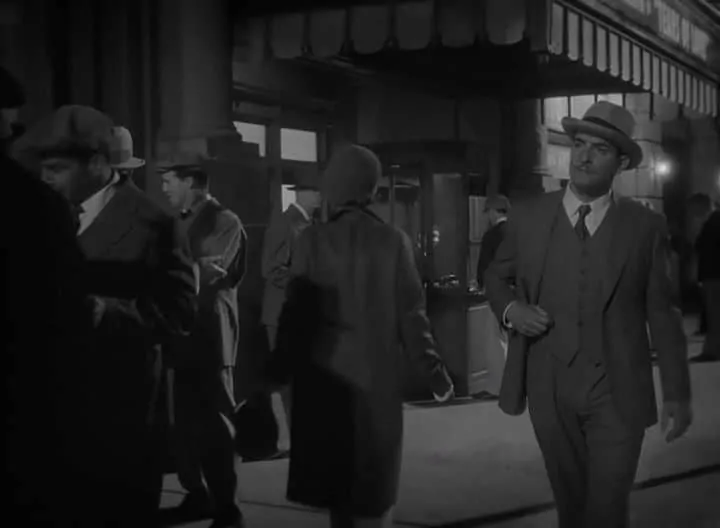
Conclusion
While the film techniques and approach of the silent film may be very authentic,most of the clothes are clearly modern. Most people will probably not notice the inappropriate men’s clothes, but you and I do! It seems strange that they were unable to source proper period clothes from the 1920’s and 1930’s era. What did you think of George Valentin’s clothing?
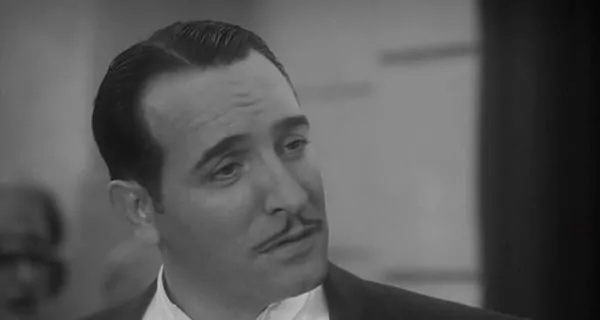
I agree. I enjoyed the film, and I believe that it is a fascinating symbol of the state of our culture today, as far as western culture is concerned, at least. We seem to be looking back in search of something that is not clear today.
However, in spite of the fact that I enjoyed checking the clothes, they were clearly modern interpretations of the period, and not actual reproductions of the era, as your article correctly states. Coat cut and details, lapel width, and vest design were not really 20’s to 30’s transition apparel. I believe that some of the shirt collars were also not very accurate (wider than they would be, in terms of tie knot space). And it would have been nice to see a double breasted vest with those peaked lapel single breasted coats…
I agree Manuel, especially the evening shirt collars did not seem authentic to me.
Most of what Sven wrote above is true, but he has made several inaccurate or incorrect statements here and there:
“In the close up, you can see that Dujardin wears a tuxedo with flaps on the pockets – again, a highly informal detail that no man would have worn back then.”
False: on American tuxedos, flaps were the norm throughout the 1920s and most of the ’30s.
“…the cut of the waistcoat – with the bottom button fastened – is not the way men wore it back in the day.”
False: In the U.S., waistcoat bottom buttons were usually worn fastened.
“While the film techniques and approach of the silent film may be very authentic, the clothes are clearly modern.”
Not completely true. On certain supporting actors and many of the extras, the clothes are authentic vintage, even 1930s vintage. And all of the neckties worn by Jean Dujardin are authentic vintage 1930s pieces.
Dear Marc,
Thank you for your detailed comment – I really appreciate that. Please do that more often!
With regards to the flaps, I agree, that few tuxedo jackets in the 1920’s and 1930’s had flaps. However these, were the exception and no elegant man would have worn them. I have only seen flaps on a tuxedo twice but about 85 from that time period without flaps. One of the men’s clothing magazines at the time, Apparel Arts would always advocate in favor of jetted pockets. I will amend the text to “no elegant man”.
With regards to the waistcoat, I do have a huge picture archive of about 80,000 – 100,000 pictures and illustrations and the bottom button is almost always undone, especially by men who dress well. However, I would love to see your pictures that show men with buttoned waistcoats. Please send them to me by email, thanks.
I specifically wrote that the ties looked authentic 1930’s. Which of the suit was original 1930’s?
Please let me know, I look forward to hearing from you!
I have to admit to not having yet seen The Artist, however from the stills it seems to give a good impression of the feel of 20’s fashion – it was never very strict in California as one might imagine, it being the rules of taste and style. I’ve also heard that double-breasted waistcoats (much as I love them) were seen at times as being in poor taste.
As a fan of Jean Dujardin, I do find that he looks best in traditional styles (and only with slicked back hair) – I highly recommend watching OSS117, Cairo, Nest of Spies, which was set in “1955” and quite true to the period, albeit one about 5/8 years later.
And here are some waistcoats with the bottom button fastened.
Charlie Chaplin’s:
Clark Gable’s:
John Gilbert’s:
James Cagney’s:
Thanks for all these pictures. I will reply in a separate post but check out the first picture in our article about Fred Astaire, and you will see that he wears his bottom button unbuttoned. It was certainly a British Fashion and the elegant men in the US look the Britain for style and rules. Of course, there were some that did not know that or care about it, but the majority of well dressed men left it unbuttoned. More pictures to follow.
Thank you for taking my comments in gracious stride, Sven. I will be happy to elaborate. Let’s begin at the end, so to speak.
The following suits are authentic vintage pieces. Except for John Goodman’s “other” suit (which is from the ‘40s), all of them are from the 1930s, IMO.
John Goodman’s suit:
John Goodman’s other suit: http://relax.ua/wp-content/uploads/gallery/2012/2/the-artist-4.jpg
James Cromwell’s suit:
Malcolm McDowell’s suit:
Every belted-back suit seen in the film. (No photos available on the Internet.)
We’d have to sit down and go through the features. None of them look particularly 1920s to me. and for the thirties they do not have the right cut. However, at any given time, there men would wear old suits and new suits, resulting into different styles… We’d have to cover that in another post though.
You’re very welcome, Sven. Perhaps the best thing, for accuracy’s sake, would be for you to change the statement “not the way men wore it back in the day” to “not the way America’s more elegant men wore it back in the day.”
I agree with you that Astaire, Beebe, Biddle, and the like wore their waistcoats’ bottom button unfastened, but still must insist that the majority of American men in the ’20s and ’30s –even such movie stars as Gable (who had Eddie Schmidt, Inc. as his tailor) and Cagney (same)– fastened the bottom button.
Marc, it stands corrected now. Did you get the email I sent you?
Haven’t seen your e-mail yet. I’ll look at it now.
Meanwhile, I can’t resist posting these two links showing Adolphe Menjou with his waistcoat’s bottom button fastened. ;-) Don’t hate me, it’s all in good fun!
http://www.ebay.com/itm/1926-ADOLPHE-MENJOU-ACTOR-WITH-WIFE-Press-Photo-/160731176479?pt=Art_Photo_Images&hash=item256c531e1f
http://www.ebay.com/itm/CGC-Photo-ADOLPHE-MENJOU-Portrait-CERTIFIED-AUTHENTIC-/350529081092?pt=Art_Photo_Images&hash=item519d294f04
And it looks awfully tight on him, too. One wonders why Menjou didn’t look in the mirror and unbutton the darn thing?
The film was AMAZING.
A recreation of the 1920’s and 1930’s cannot acheive total authenicity, and there will be some small lapses, such as an adjustable bow tie. It might not have occured to the costume designer to custom order a tie, and at the last minute he had to purchase a RTW one.
I think that overall, it was a marvelous acheivement. When the actors speak for the first time at the very end, it is a bit of a letdown in that we have left this fantasy world of silence.
The lead character, George Valentin, was based in part on Douglas Fairbanks, Jr., who was known for his action films, all-American can-do spirit, and stuntwork. In fact, Valentin views a clip of Fairbanks’s “The Mark of Zorro” in his home, and we are to take it that Valentin is viewing one of his old films.
The Valentin character is also based in part on John Gilbert who was a leading silent star who could not make the transition to talkies. However, Gilbert made talking pictures, but he flopped. He was left in the limbo of being a “has been” star. In comparison, Valentin is summarily dismissed from the studio once sound arrives, and Valentin indpendently makes his own silent film which no one wants to see. In comparison, MGM at least tried to transition Gilbert to sound although some believe that Louis B. Mayer sought to sabotage Gilbert’s career due to insubordination.
Raphael, I must disagree with you that Rudolph Valentino was an inspiration although the Valentin name brings-up associations of Valentino. Valentino died at the height of his popularity, and he never made a sound picture. He also was not an adventure star, such as Fairbanks. Valentino was a smoldering, Latin lover. Perhaps, if Valentino had lived, his Italian accent would have consigned him to “has been” status.
It should also be noted that the film is not a total recreation of a silent film. There were borrowings from other periods, such as the love theme from “Vertigo” (late 1950’s) and the closing number to “Swing, Swing, Swing” (mid 1930’s).
Dear Mark,
Thanks for your detailed comment. Personally, I was not a huge fan of the movie and my criticism was not just focused on the bow tie. They publicly bragged about their authenticity and as such I looked at it very thoroughly.
Thanks for mentioning Gilbert, I also thought about Emil Jannings as a role model. Do you know him?